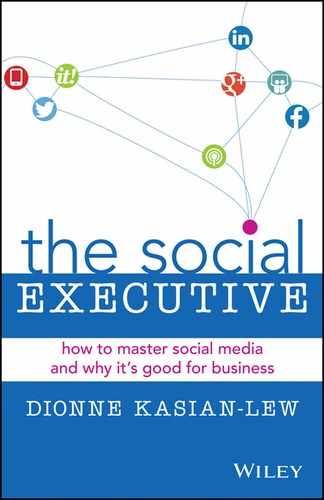Conclusion
The Social Executive promise fulfilled
Executives who have been asking why social media is important for business and how to involve themselves now have some answers.
The Social Executive presents powerful evidence from the best consultancies around the world on the value of the connected economy and its predicted growth.
In these chapters you’ve learned:
- to separate the fact from fiction on social media
- that it’s not a fad, a young person’s game or merely for posting photos of lunch, but a powerful professional and business tool to be applied across every industry and area of the business
- that social media is a deeply entrenched form of communication that is still growing rapidly and turning the way we do business on its head
- that there’s strong evidence in support of investing in social business in your industry
- to challenge past perceptions and adopt a social media mindset
- what the key social media platforms are and how to use them
- how to use social media for professional development
- about some key legal and corporate governance issues that executives need to manage through sound policies and practices
- to establish and grow a Professional Platform.
A Professional Platform will help you establish and grow online influence and leverage your existing expertise and experience in new ways.
As I said at the start, there’s no mystique to social media. But there is magic. As in real life, so in the digital realm. I look forward to meeting you there.
Now let’s schedule your ongoing social strategy in a practical way.
Your social strategy
Daily
- Go to @Notifications in Twitter if you can, see who’s connected with you, reply and engage in conversation.
- Check your LinkedIn inbox.
- LinkedIn will notify you if someone comments on a status update — respond if you can.
- If you have time to look at content in a LinkedIn group that’s well set up and active, do.
Google Plus
- Notifications from your network will appear in the Social section. You’ll be signalled if you’re mentioned. You will also receive notifications from communities. Respond if you can.
Weekly
- Clean up your Twitter stream using ManageFlitter or a similar hygiene tool.
- Follow people you like on Twitter who have followed you.
- Do a ‘big follow’ if you can by going to the following of someone whose feed you admire and connecting with their followers.
- Respond to invitations.
- Reach out to networks.
- Choose one group that you believe will really add professional value. Read material and make comments.
Google Plus
- Scan the ecosystem and +1 posts you like.
- If you’re in a community, spend time reading content and commenting on it or posting content that you find interesting and that’s relevant to that community.
Scoop.it
- Read, comment and scoop content. Share immediately through relevant social media networks or push content into your buffer.
Monthly
SlideShare
- Do you have a presentation to share on SlideShare? Remember to save it as a PDF, and ensure it makes sense without a presenter to explain it.
..................Content has been hidden....................
You can't read the all page of ebook, please click here login for view all page.
